If you’re considering growing mushrooms and reading mushroom growing books and articles on the subject, you’ve probably come across the term Master’s Mix.
Many amateur and commercial growers use Master’s Mix to grow large quantities of wood-loving mushrooms.
But what exactly is a Master’s Mix, and can you make it at home?
In this article, we explore what it is, who invented Master’s Mix, which mushrooms grow on Master’s Mix and its pros and cons.
We also provide step-by-step instructions on how to make a Master’s Mix, and troubleshoot two of the most common issues encountered.
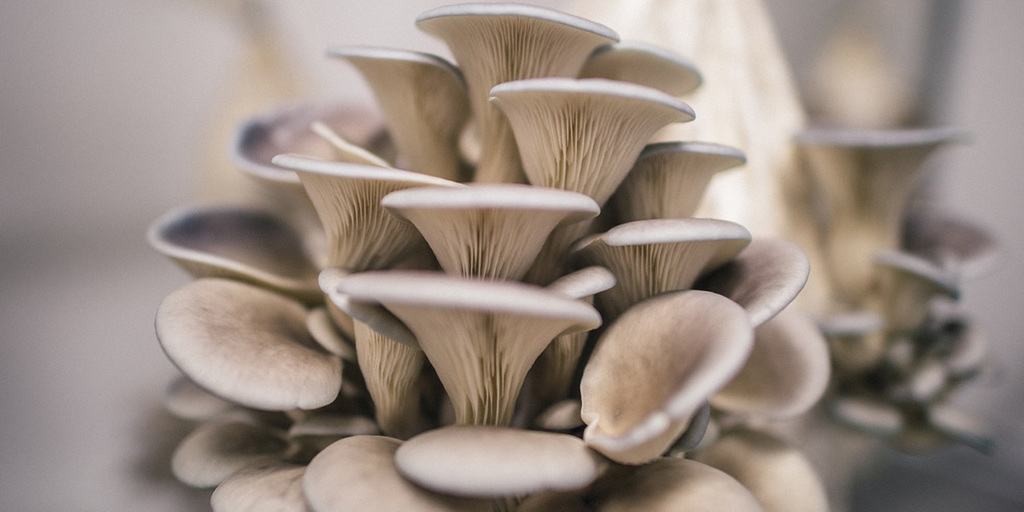
What is Master’s Mix?
Master’s Mix is the name given to a mushroom substrate blend made from a 50:50 mix of hardwood sawdust and soybean hulls.
For those new to mushroom growing, a substrate is any organic material that mushroom mycelium can use to grow and establish itself.
A good substrate provides mycelium with the moisture, nutrients and energy required to grow and produce mushrooms.
Different types of mushrooms prefer different substrates. There are several mushroom substrate recipes available tailored to specific mushroom species.
Growers have perfected these mushroom substrate recipes to create substrate blends that provide optimal nutrition and boost yields.
The Master’s Mix recipe creates a substrate fruiting block that often provides a larger than average first flush of mushrooms.
Who Invented Master’s Mix?
T.R. Davis of Earth Angel Mushrooms was the first person to run trials using substrates made from a mix of hardwood sawdust and soybean hulls.
And although other people tried using soybean hulls as mushroom substrate, growers credit him with inventing the Master’s Mix recipe.
He ran the Master’s Mix trials to look for straw alternatives and to try substrate materials available in his area year-round.
Sawdust was plentiful and easy to source, but mushrooms don’t produce the best yields on hardwood sawdust alone.
Soybean hulls seemed like a good option since they’re available all year round, inexpensive and high in cellulose and other nutrients that mushrooms enjoy.
Davis ran trials using substrate blocks with different percentages of sawdust and soybean hulls, starting with 10% soybean hulls and 90% sawdust all the way to 70% soybean hulls and 30% sawdust.
He settled on a 50% soybean hull, 50% sawdust mix, and most growers agree that this is the ideal ratio.
With more than 50% soybean hulls, the mixture has excess nutrients and the risks of contamination or deformed mushrooms increases.
And, using less than 50% soybean hulls provides insufficient nutrients, and mushroom yields decrease.
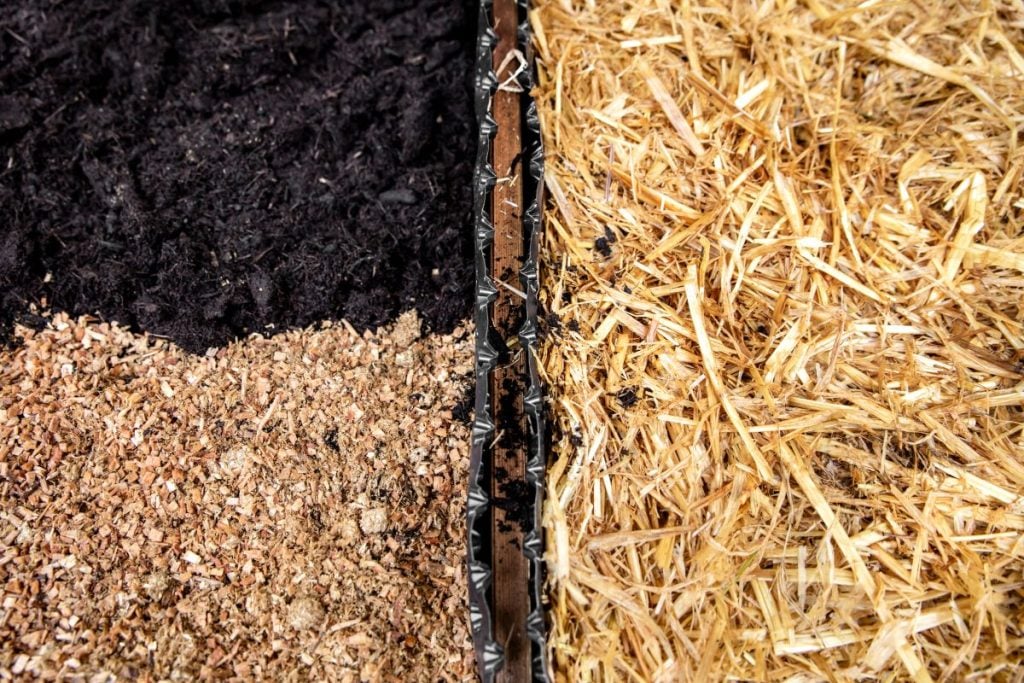
Which Mushrooms Grow Well on a Master’s Mix Substrate?
Most wood-loving mushrooms will grow on Master’s Mix, including oyster, lion’s mane, chestnut, shimeji and enoki mushrooms.
But, shiitakes, although wood-loving, do better on hardwood sawdust blocks amended with low levels of wheat or oat bran.
Oyster mushrooms are some of the easiest mushrooms to grow, making them popular with beginner and hobby mushroom growers.
Substrates with a lot of supplementation, like Master’s Mix, can cause lower shiitake yields and deformed fruiting bodies.
And, as there are so many oyster mushroom varieties, like blue, pink, pearl, yellow and phoenix oysters, it’s easy to find one to grow year-round.
While oyster mushrooms grow on almost anything, including coffee grounds, cardboard, straw and sawdust blocks, they produce excellent yields when grown on Master’s Mix substrate blocks.

Does Reishi Grow on Master’s Mix?
Yes, reishi does grow on Master’s Mix, but such high levels of supplementation are not necessary to get good reishi yields.
Many growers believe somewhere between 5% and 15% supplementation is the best when growing reishi.
Pros and Cons of Master’s Mix
Master’s Mix is a popular substrate blend, and many growers consider it one of the best substrates for most wood-loving mushroom species.
But whether it’s the best substrate for you depends on the mushrooms you want to grow, what’s available in your area and how easily you can source hardwood sawdust and soy hulls.
Here are some of the pros and cons of Master’s Mix:
Pros
- You can grow a wide variety of mushroom species on Master’s Mix.
- It provides a lot of supplemental nitrogen and minerals producing good yields.
- You can buy sawdust and soybean hulls in pellet form, making storage and production processes easier.
- It’s a well-established substrate mix used by many gourmet mushroom growers.
Cons
- It’s not the best substrate for shiitake as the nitrogen content is too high.
- The high levels of supplementation mean Master’s Mix requires sterilization in an autoclave or steam sterilizer.
- It requires a sterile inoculation process in lab conditions to avoid contamination.
- Some species take longer to colonize Master’s Mix than other substrates.
- The second flush of mushrooms is often not as good as when using sawdust and bran, but often the first flush makes up for it.
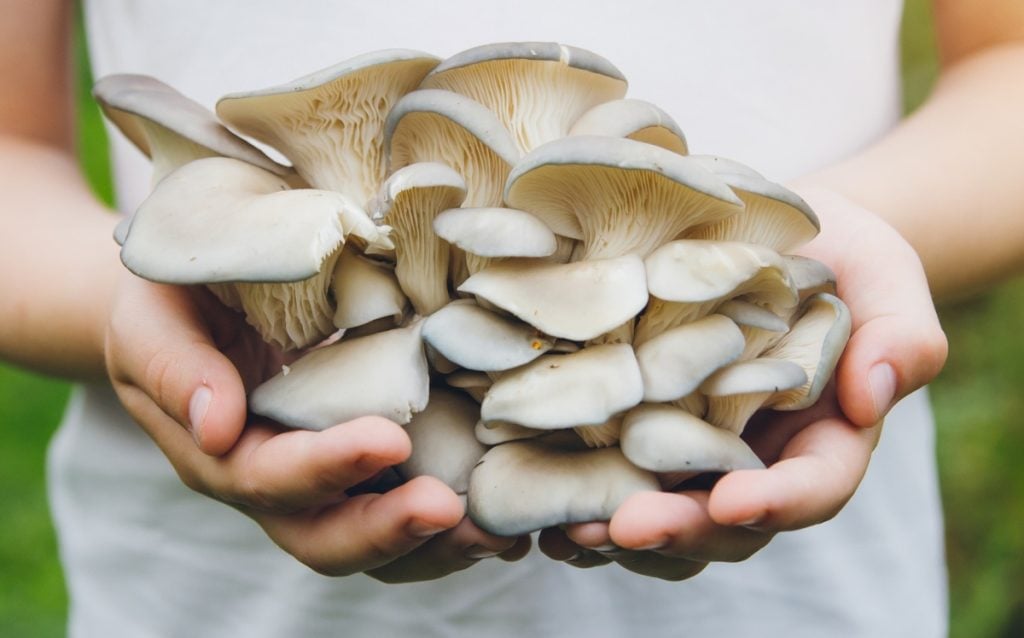
How to Make Master’s Mix Step by Step
For those wondering, “How do you make a Master’s Mix?” The good news is it’s relatively straightforward.
To put it simply, you combine equal amounts of sawdust and soybean hulls, hydrate the mixture to 60% and then sterilize it in a pressure cooker.
Make your own Master’s Mix at home using the steps below:
Step 1: Gather Supplies
The first step is to gather all the ingredients and equipment required.
Ingredients
Master’s Mix only has 3 ingredients:
- Hardwood sawdust or pellets: If you live somewhere where clean hardwood sawdust is scarce, an easy alternative is the hardwood fuel pellets used for pellet stoves, as they’re readily available in most areas.
You can also buy hardwood pellets online that are specifically for mushroom growing.
- Soybean hulls or pellets: If you live in a rural area near a soy farm, you may find whole soy hulls, but you commonly find them in pellet form.
Soy hull pellets are commonly used as a feed supplement for cattle and horses and are widely available in agricultural feed stores.
- Water: Depending on where you live, you can usually use tap water at this stage of mushroom cultivation.
Equipment
You don’t need expensive equipment to make a Master’s Mix substrate block. Most are common household items, including:
- Measuring cups
- A scale
- Bucket or tote for mixing
- Mushrooms growing bags
- A pressure cooker
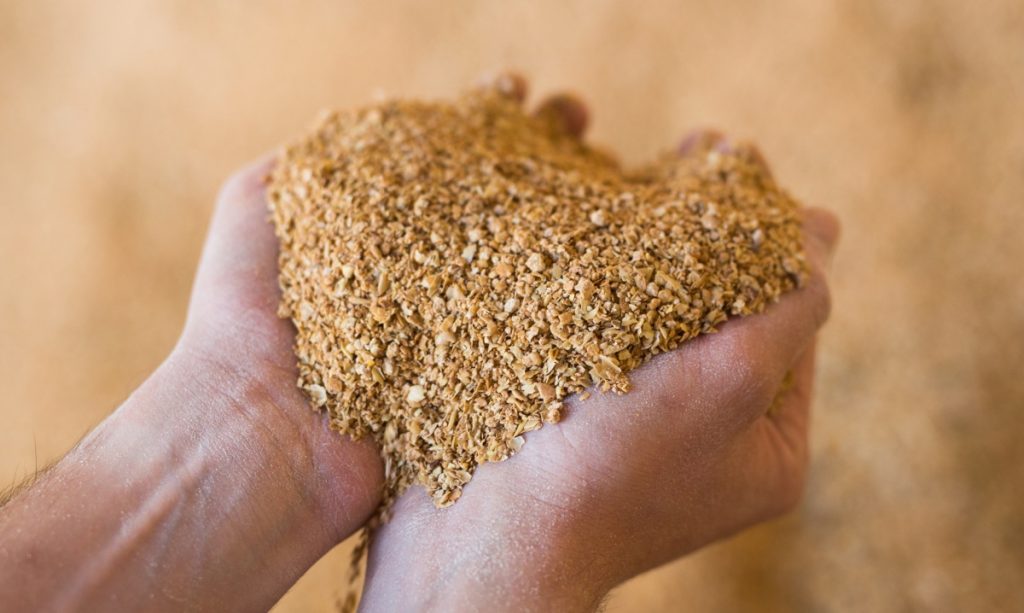
Step 2: Weigh or Measure the Dry Ingredients
Depending on the size of your grow bags, you’ll need to weigh the appropriate amount of dry sawdust and soy hulls.
To make a five-pound block of Master’s Mix, you need:
- 1 pound (453 grams) of sawdust
- 1 pound (453 grams) of soybean hulls
- 1.4 liters of water
And, if you’re using hardwood pellets and pelleted soy hulls, you need:
- 2.5 cups hardwood fuel pellets
- 2.5 cups soy hull pellets
- 1.4 Liters of water
Step 3: Add Water
Now you need to hydrate your dry ingredients. Soy hull pellets can take longer than hardwood fuel pellets to absorb water and break apart.
You may want to soak the soy hull pellets in 700ml of water overnight, or if you’re in a hurry, try using boiling water, as this will speed up the process.
Add the other 700ml of water to the hardwood pellets in a bucket or bowl and soak for 30 minutes. They will break apart and become sawdust.
Some growers combine the dry ingredients and water in the bag and allow the pellets to rehydrate and break apart, but it’s not as easy to mix the ingredients evenly using this method.
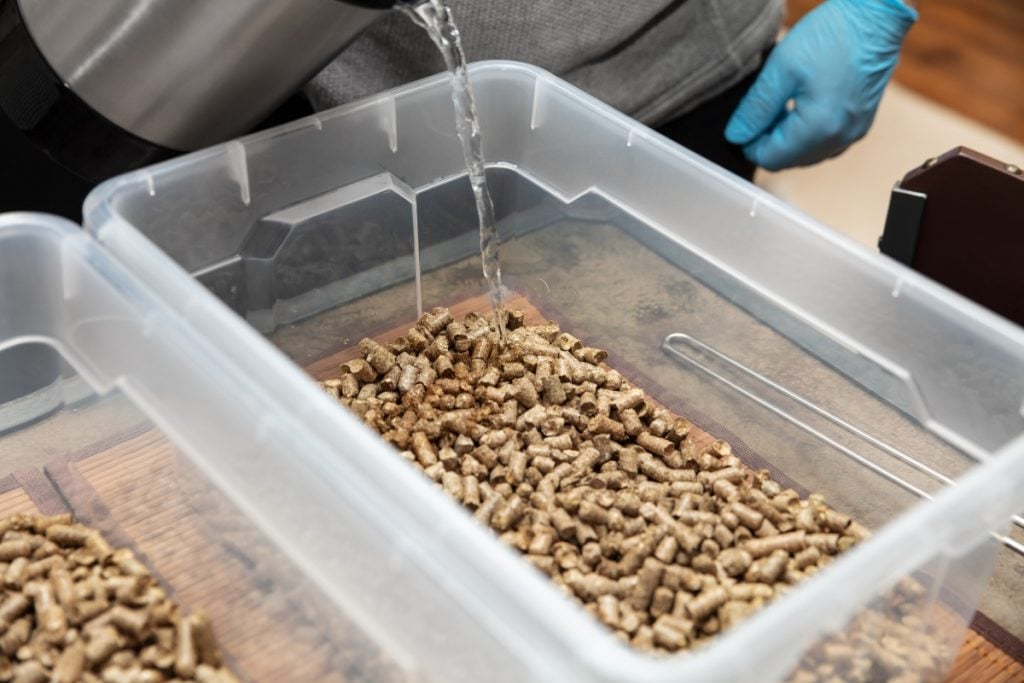
Step 4: Mix and Load Into Bags
Combine the hydrated soybean hulls and sawdust in a large tote or bucket and mix them well.
The easiest way to mix substrate is with your hands. Wash them thoroughly before you begin, or consider wearing disposable gloves.
You can also use a large spoon, sturdy plastic scoop or even a shovel if you’re mixing lots of substrate.
Load the well-mixed substrate into your mushroom grow bags, squeeze out as much air as possible and fold the bag according to instructions.
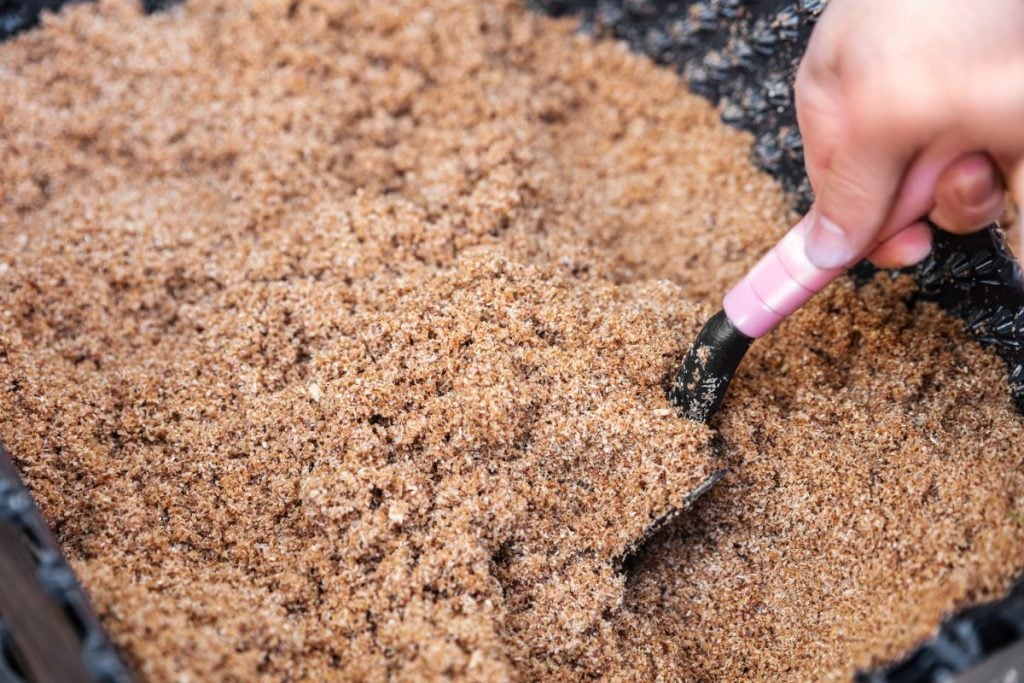
Step 4: Sterilize Your Substrate
You don’t need to sterilize hardwood pellets if you’re using them alone, as the heat and pressure used in the pellet production process do this.
But, when you add soybean hulls to create a Master’s Mix, you increase the chances of contamination and the whole mixture needs sterilizing.
How Do You Sterilize Master’s Mix?
To sterilize a Master’s Mix substrate, place it under pressure and expose it to temperatures higher than 250°F (121°C).
The aim is to eliminate all contaminants, living and dormant, that may be in the substrate.
The best way to achieve this at home is using a pressure cooker.
Place the bags of Master’s Mix in your pressure cooker, making sure to use jar lids or a rack to keep the bags from making direct contact with the bottom and burning.
Ideally, weigh down the bags with a plate or something heavy to prevent them from blocking the pressure relief valve on the pressure cooker lid.
Pressure sterilize your bags of Master’s Mix for 2.5 hours at 15PSI.
Then turn off the heat and allow the sterilized substrate to cool in the pressure cooker. This process can take up to 8 hours.
When completely cool, your Master’s Mix substrate is ready for inoculation. It’s best to do this in front of a laminar flow hood to help prevent contamination.
Common Issues When Making and Using Master’s Mix (and How to Troubleshoot Them)
Like all new skills, learning to make Master’s Mix and grow mushrooms takes practice, and trial and error is part of the process.
Here are two of the most common problems encountered when using a Master’s Mix and how to prevent them.
1. Contamination
Mushroom contamination is the most common reason for failure when growing mushrooms, and the high ratio of soybean hulls in the Master’s Mix recipe increases the chances of contamination.
Improper sterilization or a non-sterile inoculation process are the most common causes of contamination.
Sterilization
Always follow the sterilization method carefully and fully sterilize your substrate.
While there are other methods of sterilizing, they’re often not as effective as a pressure cooker, making this the best option, especially for beginner mushroom growers.
Don’t cut corners or rush the process. Leave the pressure cooker on a little longer if necessary to be sure you properly sterilize your Master’s Mix.
Check the pressure regularly while the substrate is in the pressure cooker.
Inoculation
Once you have sterilized the Master’s Mix, it’s time to inoculate it, and this is the next danger spot for contamination.
Before starting, wipe down all work surfaces and clean your hands and any equipment well with soap.
If possible, inoculate your Master’s Mix in front of a laminar flow hood, as this helps prevent contamination.
Laminar flow hoods provide an uninterrupted steady flow of filtered clean air that helps to prevent airborne contaminants from getting into the substrate during inoculation.
Many mushroom growers build their own DIY Laminar flow hoods using a HEPA filter, fan and container or box of some sort.
But, if you’re new to mushroom growing, you can use a glove box for inoculation and disinfectant spray to reduce the number of spores in the air around your workstation.

2. Slow Colonization
There are several reasons why the colonization rate might be slower than it should be, but overhydrated substrate is the most common cause.
Before adding your mixed substrate to your bags or containers, you should test it to check the moisture levels.
The easiest way to test is to pick up a handful of the mixed substrate and do a squeeze test.
Squeeze the handful of substrate lightly. If more than a drop or two of water comes out, it’s too wet, and you need to add some dry substrate to adjust it.
If no water comes out and the substrate isn’t staying together in your hand, it’s too dry, and you’ll need to add a little water.
Another reason for slow or no colonization is inoculating the substrate before it is cool enough, as higher temperatures can kill the mushroom mycelium.

Final Thoughts
Master’s Mix is a popular mushroom substrate blend that provides all the nutrients necessary for high yields and healthy mushrooms.
Growers use Master’s Mix substrate to grow various saprotrophic mushroom species that feed on dead and decaying wood in the wild.
But not all wood-loving mushrooms need lots of nutrition to produce excellent yields. Some like shiitake prefer lower levels of nitrogen.
Deciding which substrate to use is part of the mushroom-growing learning experience. We recommend using materials that are easy to source in your area.
To learn more, visit our Mushroom Growing Hub or explore our online mushroom cultivation courses that cater to all levels of mushroom growers.
